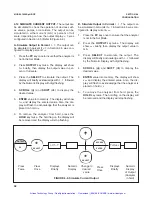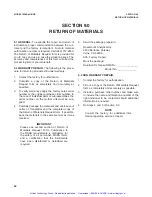
42
MODEL 1054B pH/ORP
SECTION 8.0
DIAGNOSTICS AND TROUBLESHOOTING
8.2 TROUBLESHOOTING.
The Model 1054B
Analyzer is designed with state-of-the-art micro-
processor circuitry, making troubleshooting simple and
direct. Subassembly replacement, i.e. printed circuit
board replacement, is all that is usually required.
8.2.1 Installation Failure.
If failure does occur, com-
plete the following steps:
1.
Check for a fault flag. If a fault condition exists,
refer to Table 8-1 for the fault mnemonic explana-
tion.
2.
Check wiring connections for proper installation.
3.
Refer to Troubleshooting Table 8-3 (pH) or Table
8-4 (ORP). The table is arranged with the most
common problems listed first.
8.2.2 LCD/LED Display Test.
Display Mnemonic
dtS
.
Selecting this option will activate all the display seg-
ments. This item is used if a faulty display is suspect-
ed. Refer to Figure 3-1.
1.
Enter Set Mode by pressing
ACCESS
key twice.
2.
SCROLL
(
é
) until
dtS
appears on the display.
3.
SELECT.
8.2.3 Software Version.
Display Mnemonic
UEr
.
Selection of this item will display the software revision
level of the CPU. This number may be requested by
factory service personnel if troubleshooting is
required.
1.
Enter Set Mode by pressing
ACCESS
key twice.
2.
SCROLL
(
é
) until
UEr
appears on the display.
3.
SELECT.
(i.e., 2.0.6 displayed.)
8.2.4 Sensor Troubleshooting.
In addition to the
fault mnemonics that relate to a possible sensor prob-
lem (Tables 8-1 and 8-3), the 1054B pH can display
the input in millivolts generated from the sensor. See
Table 8-5 for how the millivolt input relates to pH. If
the analyzer values do not agree within about 40 to
60 mV of those in the table, the analyzer has been
incorrectly standardized for pH, the reference may be
significantly poisoned, or some other significant prob-
lem exists. To read the millivolt input, go to Section
8.2.5.
For an additional diagnostics tool you can look at the
rES
impedance value as described in Section 4.6.
8.2.5 Electrode Input (1054B pH).
Display Mnemonic
Ein
. When selected, the analyzer displays the millivolt
input from the sensor. The displayed value is not tem-
perature corrected.
1.
Press the
ACCESS
key twice.
SEt
will briefly dis-
play followed by
Ein
. Not required if already in set
menu.
2.
SELECT
this item to read the mV input.
3.
Press the
PV
key to return to normal operation.
8.2.6 CPU Board Replacement.
If there is a problem
with the CPU board resulting in its replacement, spe-
cific procedures (included with the order) for calibrat-
ing the new board must be followed exactly or the
microprocessor will be improperly programmed.
Should this occur, it will be necessary to return the
analyzer to the factory for reprogramming.
8.2.7 Power Board Replacement.
If it becomes nec-
essary to replace the power board, the CPU board will
need to be recalibrated following specific procedures
that are included with the power board. Failure to fol-
low these procedures exactly will cause the micro-
processor to be improperly programmed and require
the return of the analyzer to the factory for reprogram-
ming.
8.3 INSTRUMENT MAINTENANCE.
To maintain the
appearance and extend the life of the enclosure, it
should be cleaned on a regular basis using a mild
soap and water solution followed by a clean water
rinse.
Input to Analyzer
pH
in Millivolts
15°C
(59°F)
25°C
(77°F)
50°C
(122°F)
80°C
(176°F)
0
396
410
444
486
1
340
351
381
416
2
283
293
317
347
3
226
234
254
277
4
170
176
190
208
5
113.2
117.1
127.0
138.7
6
56.6
58.6
63.5
69.4
7
0
0
0
0
8
– 56.6
– 58.6
– 63.5
– 69.4
9
– 113.2
– 117.1
– 127.0
– 138.7
10
– 170
– 176
– 190
– 208
11
– 226
– 234
– 254
– 277
12
– 283
– 293
– 317
– 347
13
– 340
– 351
– 381
– 416
14
– 396
– 410
– 444
– 486
TABLE 8-5
Sensor Input to Analyzer Verses
pH at Four Temperatures*
* These values do not apply for non-glass electrodes.
Artisan Technology Group - Quality Instrumentation ... Guaranteed | (888) 88-SOURCE | www.artisantg.com






































